Mental Health Impact: Homelessness on Young People (16-25) in London
VerifiedAdded on 2020/01/28
|11
|2876
|82
Report
AI Summary
This report investigates the significant impact of homelessness on the mental health of young people aged 16-25 in London, specifically within the London Borough of Lambeth. The research explores the direct correlation between homelessness and depression, examining the various causes that contribute to this issue, such as family breakdowns and substance abuse. Utilizing a qualitative research approach, the study employs secondary data analysis, drawing from published journals, social health care websites, and government sources to understand the problem. The report aims to identify the causes of depression among young people experiencing homelessness and to propose effective strategies for reducing depression rates. It highlights the importance of addressing homelessness as a key factor in improving the mental well-being of this vulnerable population. The methodology includes a deductive approach and thematic data analysis, with limitations acknowledged, such as the use of secondary sources and a limited sample size, while ethical considerations are carefully addressed, ensuring the integrity of the research.
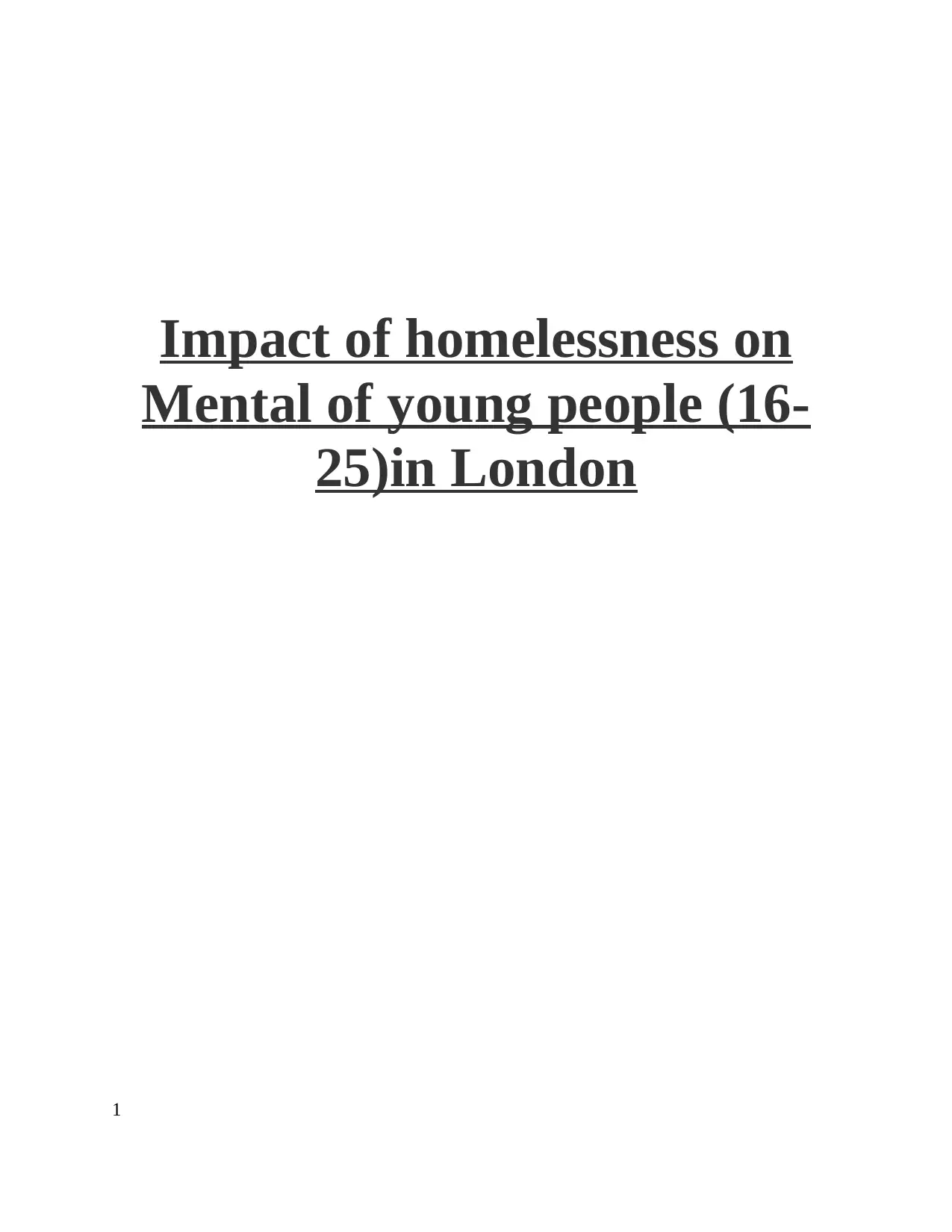
Impact of homelessness on
Mental of young people (16-
25)in London
1
Mental of young people (16-
25)in London
1
Paraphrase This Document
Need a fresh take? Get an instant paraphrase of this document with our AI Paraphraser
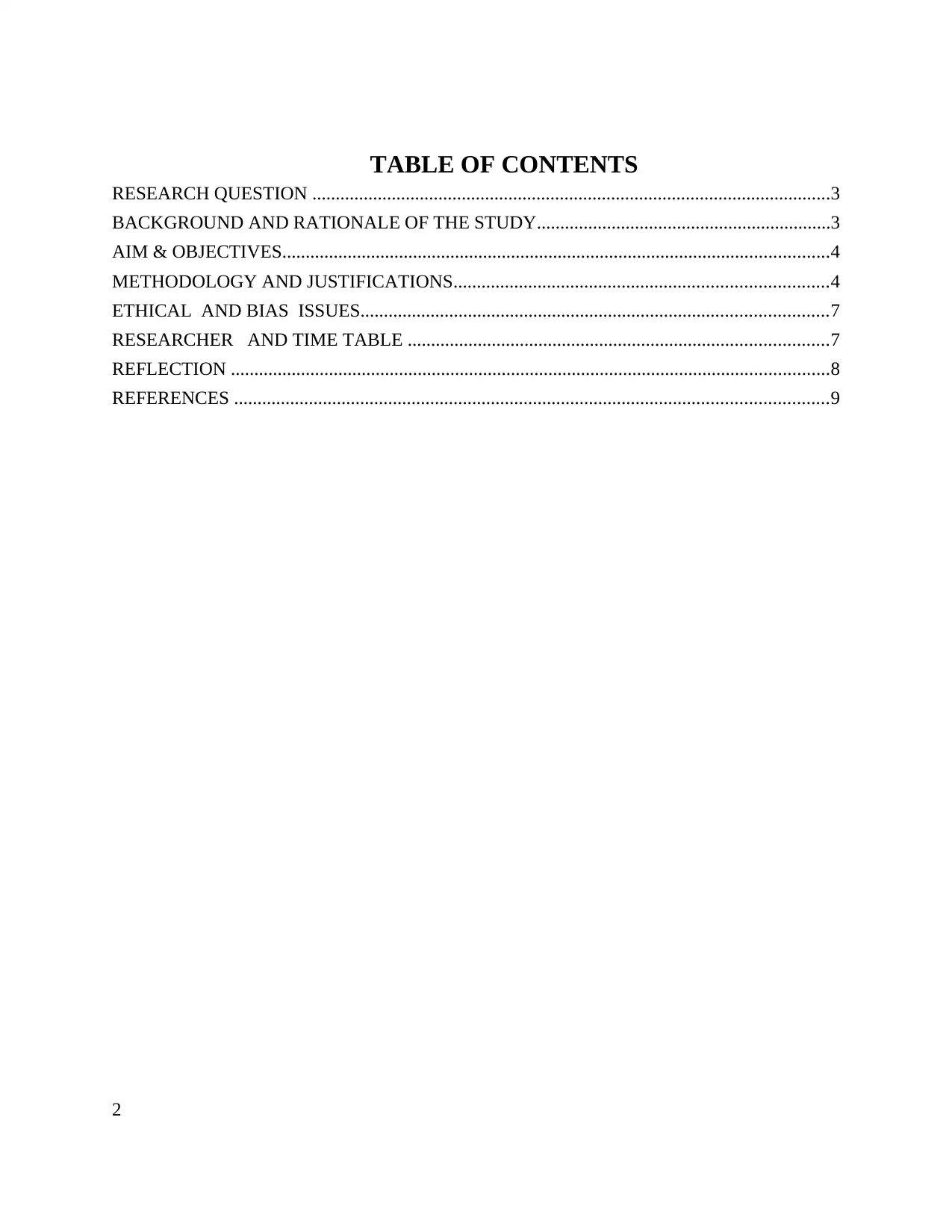
TABLE OF CONTENTS
RESEARCH QUESTION ...............................................................................................................3
BACKGROUND AND RATIONALE OF THE STUDY...............................................................3
AIM & OBJECTIVES.....................................................................................................................4
METHODOLOGY AND JUSTIFICATIONS................................................................................4
ETHICAL AND BIAS ISSUES....................................................................................................7
RESEARCHER AND TIME TABLE ..........................................................................................7
REFLECTION ................................................................................................................................8
REFERENCES ...............................................................................................................................9
2
RESEARCH QUESTION ...............................................................................................................3
BACKGROUND AND RATIONALE OF THE STUDY...............................................................3
AIM & OBJECTIVES.....................................................................................................................4
METHODOLOGY AND JUSTIFICATIONS................................................................................4
ETHICAL AND BIAS ISSUES....................................................................................................7
RESEARCHER AND TIME TABLE ..........................................................................................7
REFLECTION ................................................................................................................................8
REFERENCES ...............................................................................................................................9
2
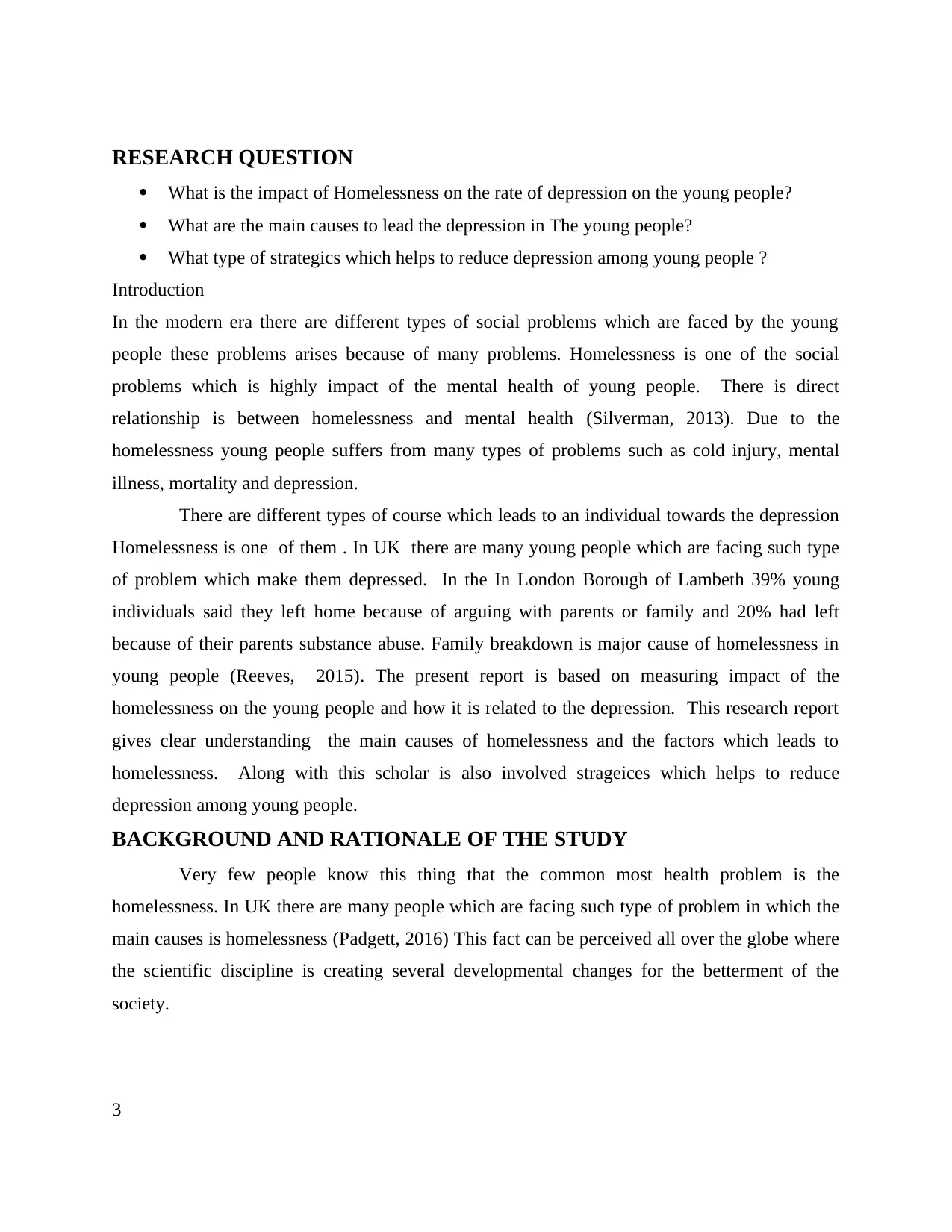
RESEARCH QUESTION
What is the impact of Homelessness on the rate of depression on the young people?
What are the main causes to lead the depression in The young people?
What type of strategics which helps to reduce depression among young people ?
Introduction
In the modern era there are different types of social problems which are faced by the young
people these problems arises because of many problems. Homelessness is one of the social
problems which is highly impact of the mental health of young people. There is direct
relationship is between homelessness and mental health (Silverman, 2013). Due to the
homelessness young people suffers from many types of problems such as cold injury, mental
illness, mortality and depression.
There are different types of course which leads to an individual towards the depression
Homelessness is one of them . In UK there are many young people which are facing such type
of problem which make them depressed. In the In London Borough of Lambeth 39% young
individuals said they left home because of arguing with parents or family and 20% had left
because of their parents substance abuse. Family breakdown is major cause of homelessness in
young people (Reeves, 2015). The present report is based on measuring impact of the
homelessness on the young people and how it is related to the depression. This research report
gives clear understanding the main causes of homelessness and the factors which leads to
homelessness. Along with this scholar is also involved strageices which helps to reduce
depression among young people.
BACKGROUND AND RATIONALE OF THE STUDY
Very few people know this thing that the common most health problem is the
homelessness. In UK there are many people which are facing such type of problem in which the
main causes is homelessness (Padgett, 2016) This fact can be perceived all over the globe where
the scientific discipline is creating several developmental changes for the betterment of the
society.
3
What is the impact of Homelessness on the rate of depression on the young people?
What are the main causes to lead the depression in The young people?
What type of strategics which helps to reduce depression among young people ?
Introduction
In the modern era there are different types of social problems which are faced by the young
people these problems arises because of many problems. Homelessness is one of the social
problems which is highly impact of the mental health of young people. There is direct
relationship is between homelessness and mental health (Silverman, 2013). Due to the
homelessness young people suffers from many types of problems such as cold injury, mental
illness, mortality and depression.
There are different types of course which leads to an individual towards the depression
Homelessness is one of them . In UK there are many young people which are facing such type
of problem which make them depressed. In the In London Borough of Lambeth 39% young
individuals said they left home because of arguing with parents or family and 20% had left
because of their parents substance abuse. Family breakdown is major cause of homelessness in
young people (Reeves, 2015). The present report is based on measuring impact of the
homelessness on the young people and how it is related to the depression. This research report
gives clear understanding the main causes of homelessness and the factors which leads to
homelessness. Along with this scholar is also involved strageices which helps to reduce
depression among young people.
BACKGROUND AND RATIONALE OF THE STUDY
Very few people know this thing that the common most health problem is the
homelessness. In UK there are many people which are facing such type of problem in which the
main causes is homelessness (Padgett, 2016) This fact can be perceived all over the globe where
the scientific discipline is creating several developmental changes for the betterment of the
society.
3
⊘ This is a preview!⊘
Do you want full access?
Subscribe today to unlock all pages.

Trusted by 1+ million students worldwide
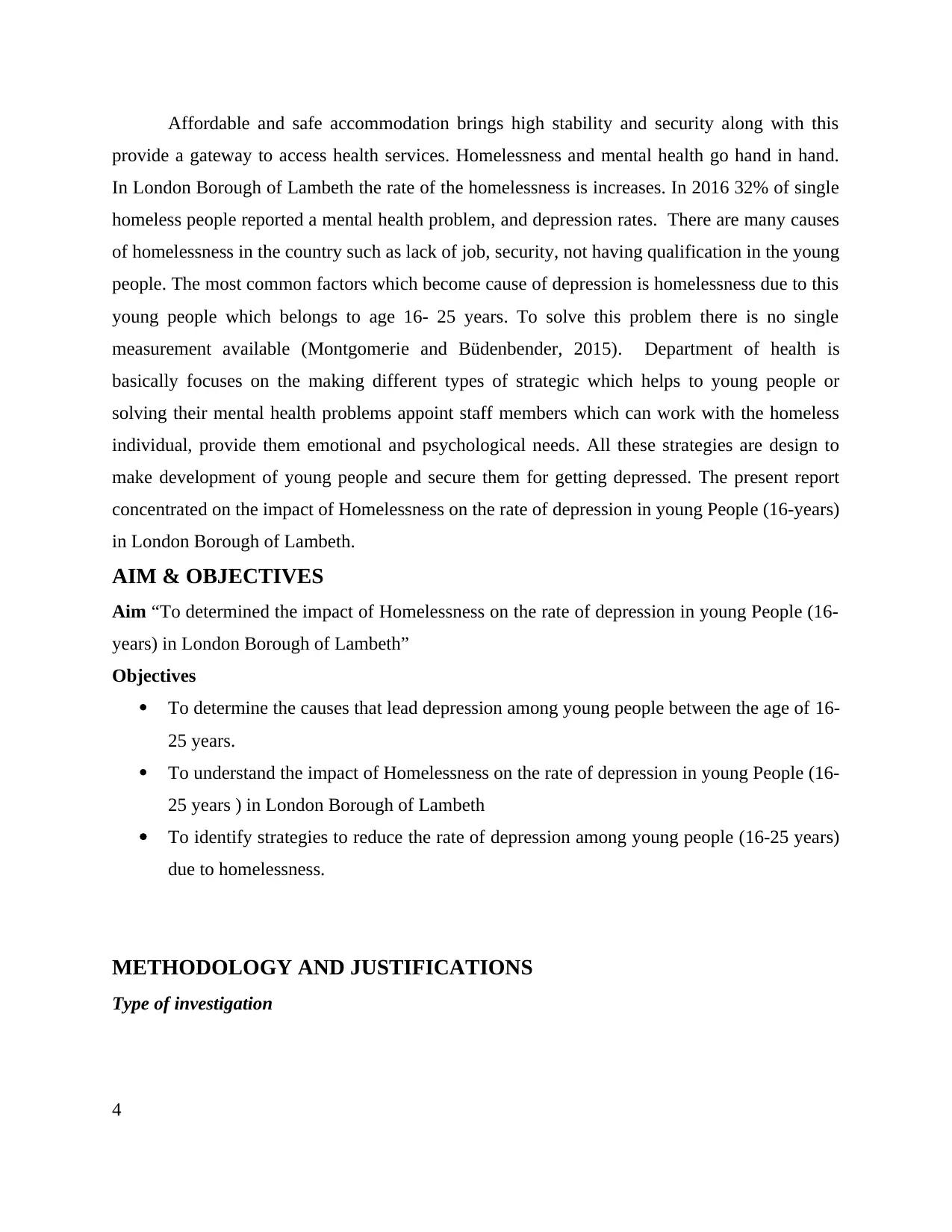
Affordable and safe accommodation brings high stability and security along with this
provide a gateway to access health services. Homelessness and mental health go hand in hand.
In London Borough of Lambeth the rate of the homelessness is increases. In 2016 32% of single
homeless people reported a mental health problem, and depression rates. There are many causes
of homelessness in the country such as lack of job, security, not having qualification in the young
people. The most common factors which become cause of depression is homelessness due to this
young people which belongs to age 16- 25 years. To solve this problem there is no single
measurement available (Montgomerie and Büdenbender, 2015). Department of health is
basically focuses on the making different types of strategic which helps to young people or
solving their mental health problems appoint staff members which can work with the homeless
individual, provide them emotional and psychological needs. All these strategies are design to
make development of young people and secure them for getting depressed. The present report
concentrated on the impact of Homelessness on the rate of depression in young People (16-years)
in London Borough of Lambeth.
AIM & OBJECTIVES
Aim “To determined the impact of Homelessness on the rate of depression in young People (16-
years) in London Borough of Lambeth”
Objectives
To determine the causes that lead depression among young people between the age of 16-
25 years.
To understand the impact of Homelessness on the rate of depression in young People (16-
25 years ) in London Borough of Lambeth
To identify strategies to reduce the rate of depression among young people (16-25 years)
due to homelessness.
METHODOLOGY AND JUSTIFICATIONS
Type of investigation
4
provide a gateway to access health services. Homelessness and mental health go hand in hand.
In London Borough of Lambeth the rate of the homelessness is increases. In 2016 32% of single
homeless people reported a mental health problem, and depression rates. There are many causes
of homelessness in the country such as lack of job, security, not having qualification in the young
people. The most common factors which become cause of depression is homelessness due to this
young people which belongs to age 16- 25 years. To solve this problem there is no single
measurement available (Montgomerie and Büdenbender, 2015). Department of health is
basically focuses on the making different types of strategic which helps to young people or
solving their mental health problems appoint staff members which can work with the homeless
individual, provide them emotional and psychological needs. All these strategies are design to
make development of young people and secure them for getting depressed. The present report
concentrated on the impact of Homelessness on the rate of depression in young People (16-years)
in London Borough of Lambeth.
AIM & OBJECTIVES
Aim “To determined the impact of Homelessness on the rate of depression in young People (16-
years) in London Borough of Lambeth”
Objectives
To determine the causes that lead depression among young people between the age of 16-
25 years.
To understand the impact of Homelessness on the rate of depression in young People (16-
25 years ) in London Borough of Lambeth
To identify strategies to reduce the rate of depression among young people (16-25 years)
due to homelessness.
METHODOLOGY AND JUSTIFICATIONS
Type of investigation
4
Paraphrase This Document
Need a fresh take? Get an instant paraphrase of this document with our AI Paraphraser
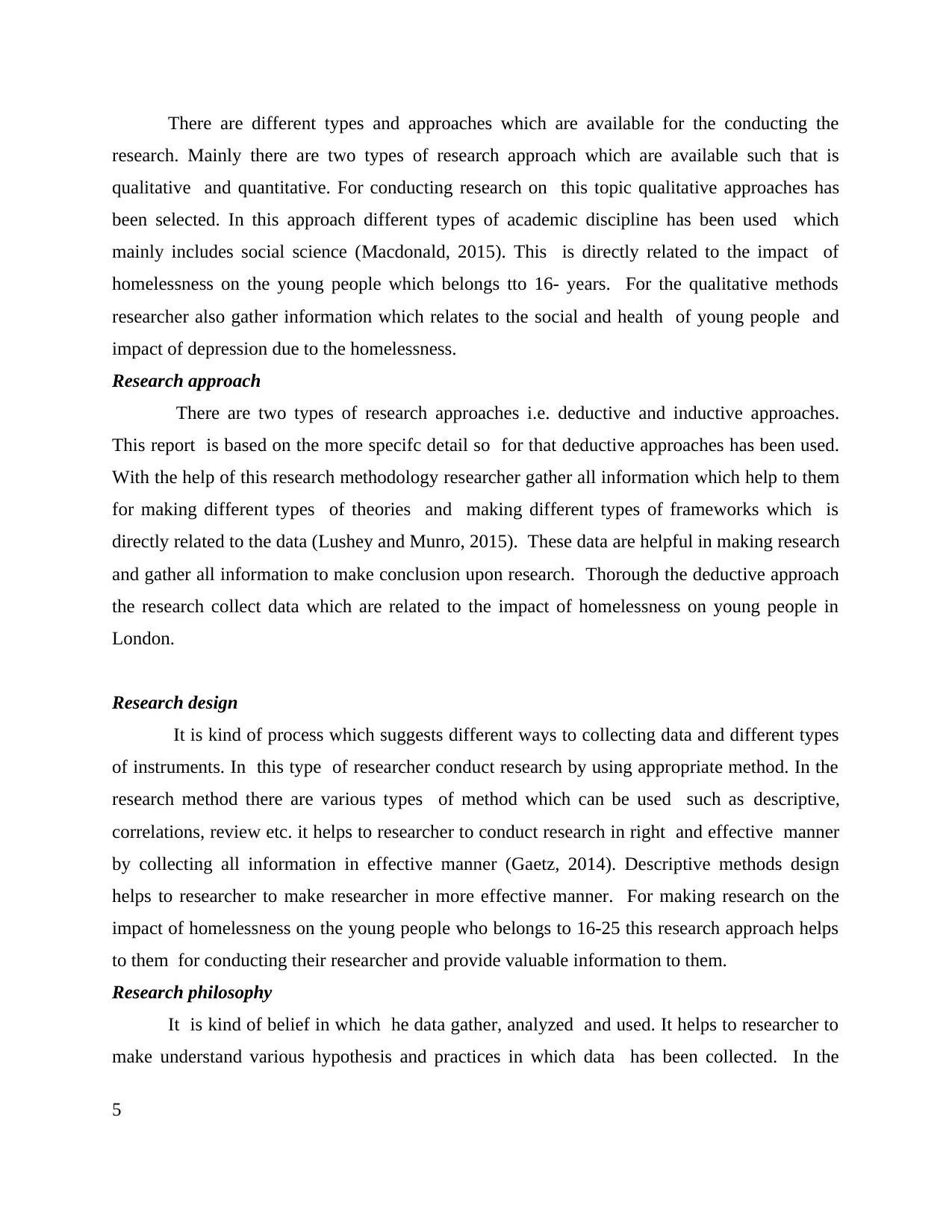
There are different types and approaches which are available for the conducting the
research. Mainly there are two types of research approach which are available such that is
qualitative and quantitative. For conducting research on this topic qualitative approaches has
been selected. In this approach different types of academic discipline has been used which
mainly includes social science (Macdonald, 2015). This is directly related to the impact of
homelessness on the young people which belongs tto 16- years. For the qualitative methods
researcher also gather information which relates to the social and health of young people and
impact of depression due to the homelessness.
Research approach
There are two types of research approaches i.e. deductive and inductive approaches.
This report is based on the more specifc detail so for that deductive approaches has been used.
With the help of this research methodology researcher gather all information which help to them
for making different types of theories and making different types of frameworks which is
directly related to the data (Lushey and Munro, 2015). These data are helpful in making research
and gather all information to make conclusion upon research. Thorough the deductive approach
the research collect data which are related to the impact of homelessness on young people in
London.
Research design
It is kind of process which suggests different ways to collecting data and different types
of instruments. In this type of researcher conduct research by using appropriate method. In the
research method there are various types of method which can be used such as descriptive,
correlations, review etc. it helps to researcher to conduct research in right and effective manner
by collecting all information in effective manner (Gaetz, 2014). Descriptive methods design
helps to researcher to make researcher in more effective manner. For making research on the
impact of homelessness on the young people who belongs to 16-25 this research approach helps
to them for conducting their researcher and provide valuable information to them.
Research philosophy
It is kind of belief in which he data gather, analyzed and used. It helps to researcher to
make understand various hypothesis and practices in which data has been collected. In the
5
research. Mainly there are two types of research approach which are available such that is
qualitative and quantitative. For conducting research on this topic qualitative approaches has
been selected. In this approach different types of academic discipline has been used which
mainly includes social science (Macdonald, 2015). This is directly related to the impact of
homelessness on the young people which belongs tto 16- years. For the qualitative methods
researcher also gather information which relates to the social and health of young people and
impact of depression due to the homelessness.
Research approach
There are two types of research approaches i.e. deductive and inductive approaches.
This report is based on the more specifc detail so for that deductive approaches has been used.
With the help of this research methodology researcher gather all information which help to them
for making different types of theories and making different types of frameworks which is
directly related to the data (Lushey and Munro, 2015). These data are helpful in making research
and gather all information to make conclusion upon research. Thorough the deductive approach
the research collect data which are related to the impact of homelessness on young people in
London.
Research design
It is kind of process which suggests different ways to collecting data and different types
of instruments. In this type of researcher conduct research by using appropriate method. In the
research method there are various types of method which can be used such as descriptive,
correlations, review etc. it helps to researcher to conduct research in right and effective manner
by collecting all information in effective manner (Gaetz, 2014). Descriptive methods design
helps to researcher to make researcher in more effective manner. For making research on the
impact of homelessness on the young people who belongs to 16-25 this research approach helps
to them for conducting their researcher and provide valuable information to them.
Research philosophy
It is kind of belief in which he data gather, analyzed and used. It helps to researcher to
make understand various hypothesis and practices in which data has been collected. In the
5
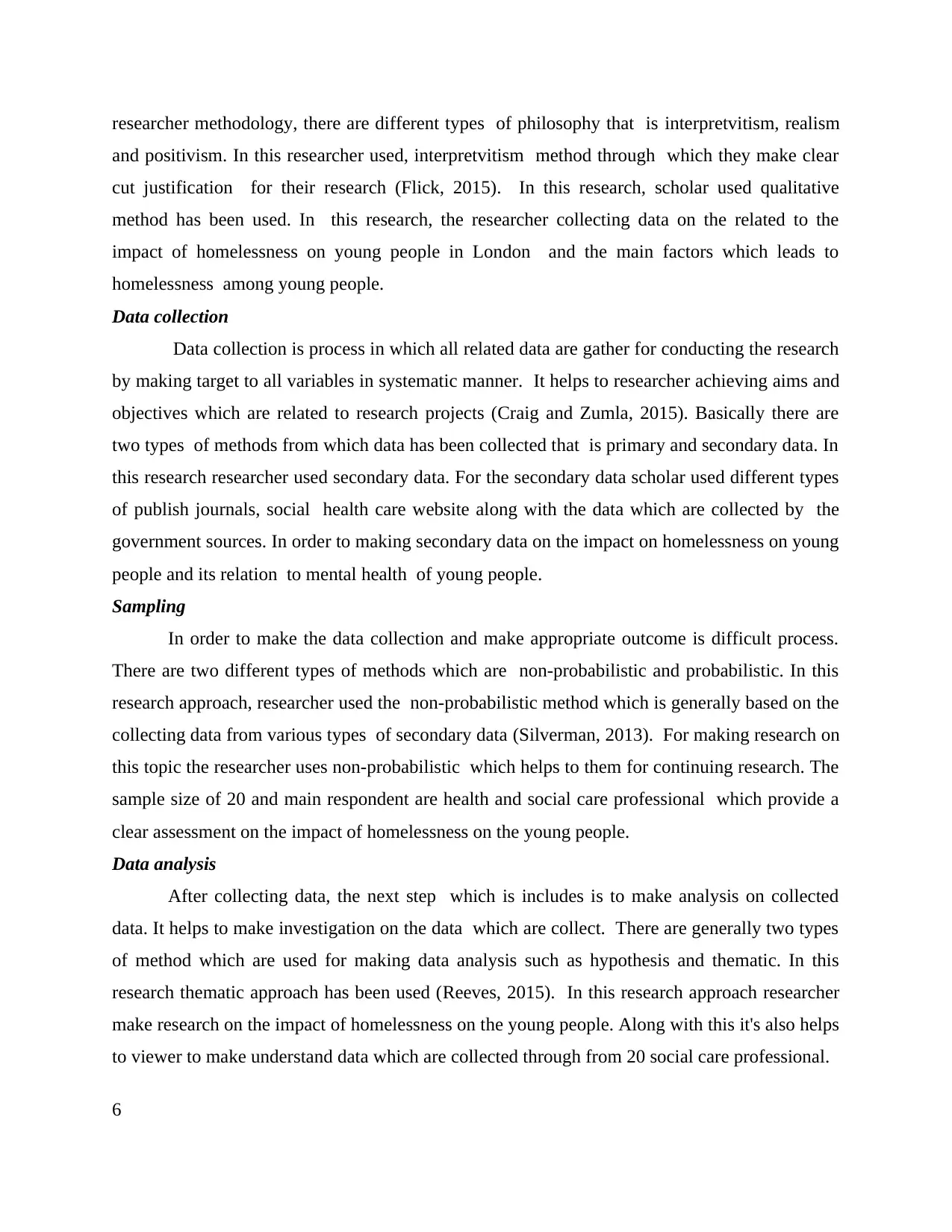
researcher methodology, there are different types of philosophy that is interpretvitism, realism
and positivism. In this researcher used, interpretvitism method through which they make clear
cut justification for their research (Flick, 2015). In this research, scholar used qualitative
method has been used. In this research, the researcher collecting data on the related to the
impact of homelessness on young people in London and the main factors which leads to
homelessness among young people.
Data collection
Data collection is process in which all related data are gather for conducting the research
by making target to all variables in systematic manner. It helps to researcher achieving aims and
objectives which are related to research projects (Craig and Zumla, 2015). Basically there are
two types of methods from which data has been collected that is primary and secondary data. In
this research researcher used secondary data. For the secondary data scholar used different types
of publish journals, social health care website along with the data which are collected by the
government sources. In order to making secondary data on the impact on homelessness on young
people and its relation to mental health of young people.
Sampling
In order to make the data collection and make appropriate outcome is difficult process.
There are two different types of methods which are non-probabilistic and probabilistic. In this
research approach, researcher used the non-probabilistic method which is generally based on the
collecting data from various types of secondary data (Silverman, 2013). For making research on
this topic the researcher uses non-probabilistic which helps to them for continuing research. The
sample size of 20 and main respondent are health and social care professional which provide a
clear assessment on the impact of homelessness on the young people.
Data analysis
After collecting data, the next step which is includes is to make analysis on collected
data. It helps to make investigation on the data which are collect. There are generally two types
of method which are used for making data analysis such as hypothesis and thematic. In this
research thematic approach has been used (Reeves, 2015). In this research approach researcher
make research on the impact of homelessness on the young people. Along with this it's also helps
to viewer to make understand data which are collected through from 20 social care professional.
6
and positivism. In this researcher used, interpretvitism method through which they make clear
cut justification for their research (Flick, 2015). In this research, scholar used qualitative
method has been used. In this research, the researcher collecting data on the related to the
impact of homelessness on young people in London and the main factors which leads to
homelessness among young people.
Data collection
Data collection is process in which all related data are gather for conducting the research
by making target to all variables in systematic manner. It helps to researcher achieving aims and
objectives which are related to research projects (Craig and Zumla, 2015). Basically there are
two types of methods from which data has been collected that is primary and secondary data. In
this research researcher used secondary data. For the secondary data scholar used different types
of publish journals, social health care website along with the data which are collected by the
government sources. In order to making secondary data on the impact on homelessness on young
people and its relation to mental health of young people.
Sampling
In order to make the data collection and make appropriate outcome is difficult process.
There are two different types of methods which are non-probabilistic and probabilistic. In this
research approach, researcher used the non-probabilistic method which is generally based on the
collecting data from various types of secondary data (Silverman, 2013). For making research on
this topic the researcher uses non-probabilistic which helps to them for continuing research. The
sample size of 20 and main respondent are health and social care professional which provide a
clear assessment on the impact of homelessness on the young people.
Data analysis
After collecting data, the next step which is includes is to make analysis on collected
data. It helps to make investigation on the data which are collect. There are generally two types
of method which are used for making data analysis such as hypothesis and thematic. In this
research thematic approach has been used (Reeves, 2015). In this research approach researcher
make research on the impact of homelessness on the young people. Along with this it's also helps
to viewer to make understand data which are collected through from 20 social care professional.
6
⊘ This is a preview!⊘
Do you want full access?
Subscribe today to unlock all pages.

Trusted by 1+ million students worldwide
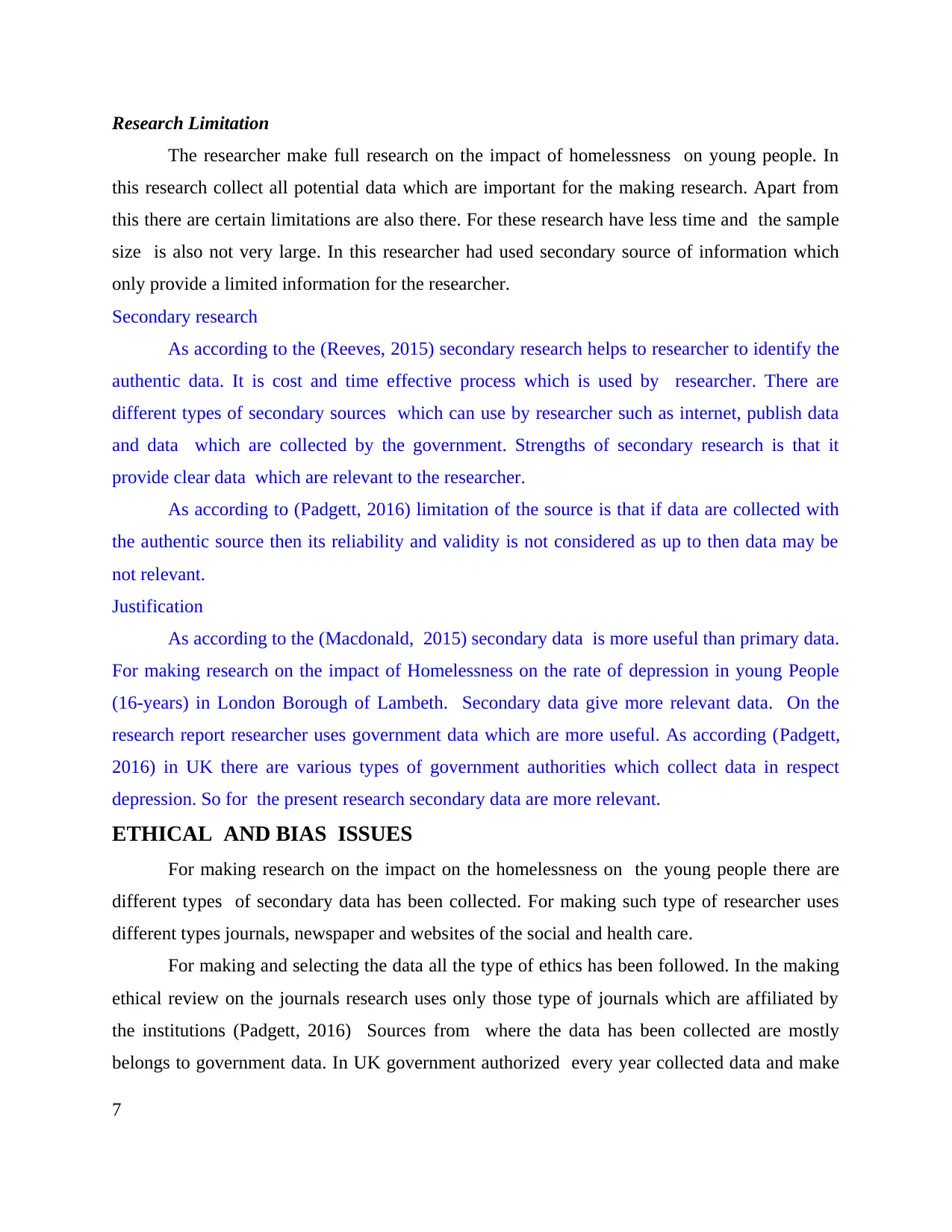
Research Limitation
The researcher make full research on the impact of homelessness on young people. In
this research collect all potential data which are important for the making research. Apart from
this there are certain limitations are also there. For these research have less time and the sample
size is also not very large. In this researcher had used secondary source of information which
only provide a limited information for the researcher.
Secondary research
As according to the (Reeves, 2015) secondary research helps to researcher to identify the
authentic data. It is cost and time effective process which is used by researcher. There are
different types of secondary sources which can use by researcher such as internet, publish data
and data which are collected by the government. Strengths of secondary research is that it
provide clear data which are relevant to the researcher.
As according to (Padgett, 2016) limitation of the source is that if data are collected with
the authentic source then its reliability and validity is not considered as up to then data may be
not relevant.
Justification
As according to the (Macdonald, 2015) secondary data is more useful than primary data.
For making research on the impact of Homelessness on the rate of depression in young People
(16-years) in London Borough of Lambeth. Secondary data give more relevant data. On the
research report researcher uses government data which are more useful. As according (Padgett,
2016) in UK there are various types of government authorities which collect data in respect
depression. So for the present research secondary data are more relevant.
ETHICAL AND BIAS ISSUES
For making research on the impact on the homelessness on the young people there are
different types of secondary data has been collected. For making such type of researcher uses
different types journals, newspaper and websites of the social and health care.
For making and selecting the data all the type of ethics has been followed. In the making
ethical review on the journals research uses only those type of journals which are affiliated by
the institutions (Padgett, 2016) Sources from where the data has been collected are mostly
belongs to government data. In UK government authorized every year collected data and make
7
The researcher make full research on the impact of homelessness on young people. In
this research collect all potential data which are important for the making research. Apart from
this there are certain limitations are also there. For these research have less time and the sample
size is also not very large. In this researcher had used secondary source of information which
only provide a limited information for the researcher.
Secondary research
As according to the (Reeves, 2015) secondary research helps to researcher to identify the
authentic data. It is cost and time effective process which is used by researcher. There are
different types of secondary sources which can use by researcher such as internet, publish data
and data which are collected by the government. Strengths of secondary research is that it
provide clear data which are relevant to the researcher.
As according to (Padgett, 2016) limitation of the source is that if data are collected with
the authentic source then its reliability and validity is not considered as up to then data may be
not relevant.
Justification
As according to the (Macdonald, 2015) secondary data is more useful than primary data.
For making research on the impact of Homelessness on the rate of depression in young People
(16-years) in London Borough of Lambeth. Secondary data give more relevant data. On the
research report researcher uses government data which are more useful. As according (Padgett,
2016) in UK there are various types of government authorities which collect data in respect
depression. So for the present research secondary data are more relevant.
ETHICAL AND BIAS ISSUES
For making research on the impact on the homelessness on the young people there are
different types of secondary data has been collected. For making such type of researcher uses
different types journals, newspaper and websites of the social and health care.
For making and selecting the data all the type of ethics has been followed. In the making
ethical review on the journals research uses only those type of journals which are affiliated by
the institutions (Padgett, 2016) Sources from where the data has been collected are mostly
belongs to government data. In UK government authorized every year collected data and make
7
Paraphrase This Document
Need a fresh take? Get an instant paraphrase of this document with our AI Paraphraser
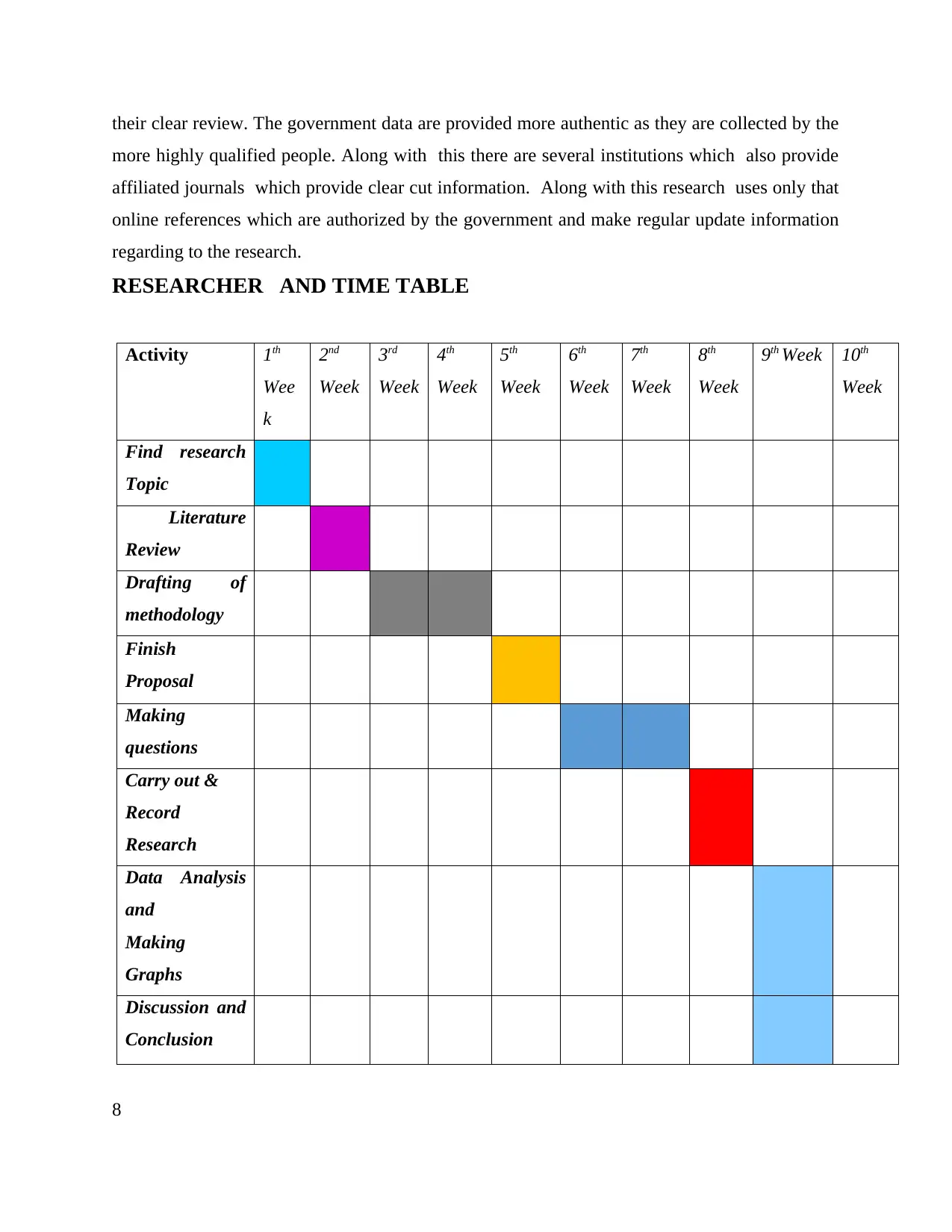
their clear review. The government data are provided more authentic as they are collected by the
more highly qualified people. Along with this there are several institutions which also provide
affiliated journals which provide clear cut information. Along with this research uses only that
online references which are authorized by the government and make regular update information
regarding to the research.
RESEARCHER AND TIME TABLE
Activity 1th
Wee
k
2nd
Week
3rd
Week
4th
Week
5th
Week
6th
Week
7th
Week
8th
Week
9th Week 10th
Week
Find research
Topic
Literature
Review
Drafting of
methodology
Finish
Proposal
Making
questions
Carry out &
Record
Research
Data Analysis
and
Making
Graphs
Discussion and
Conclusion
8
more highly qualified people. Along with this there are several institutions which also provide
affiliated journals which provide clear cut information. Along with this research uses only that
online references which are authorized by the government and make regular update information
regarding to the research.
RESEARCHER AND TIME TABLE
Activity 1th
Wee
k
2nd
Week
3rd
Week
4th
Week
5th
Week
6th
Week
7th
Week
8th
Week
9th Week 10th
Week
Find research
Topic
Literature
Review
Drafting of
methodology
Finish
Proposal
Making
questions
Carry out &
Record
Research
Data Analysis
and
Making
Graphs
Discussion and
Conclusion
8
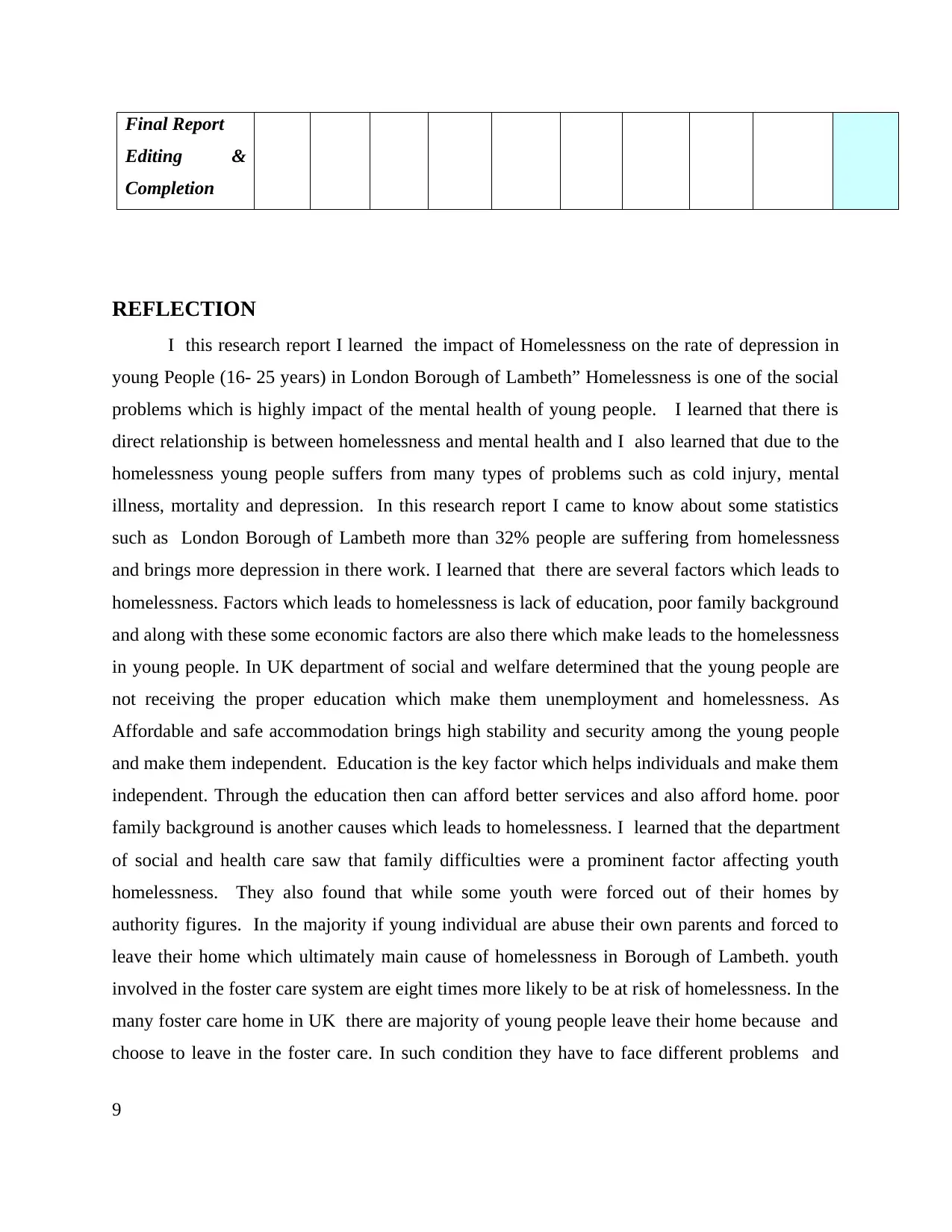
Final Report
Editing &
Completion
REFLECTION
I this research report I learned the impact of Homelessness on the rate of depression in
young People (16- 25 years) in London Borough of Lambeth” Homelessness is one of the social
problems which is highly impact of the mental health of young people. I learned that there is
direct relationship is between homelessness and mental health and I also learned that due to the
homelessness young people suffers from many types of problems such as cold injury, mental
illness, mortality and depression. In this research report I came to know about some statistics
such as London Borough of Lambeth more than 32% people are suffering from homelessness
and brings more depression in there work. I learned that there are several factors which leads to
homelessness. Factors which leads to homelessness is lack of education, poor family background
and along with these some economic factors are also there which make leads to the homelessness
in young people. In UK department of social and welfare determined that the young people are
not receiving the proper education which make them unemployment and homelessness. As
Affordable and safe accommodation brings high stability and security among the young people
and make them independent. Education is the key factor which helps individuals and make them
independent. Through the education then can afford better services and also afford home. poor
family background is another causes which leads to homelessness. I learned that the department
of social and health care saw that family difficulties were a prominent factor affecting youth
homelessness. They also found that while some youth were forced out of their homes by
authority figures. In the majority if young individual are abuse their own parents and forced to
leave their home which ultimately main cause of homelessness in Borough of Lambeth. youth
involved in the foster care system are eight times more likely to be at risk of homelessness. In the
many foster care home in UK there are majority of young people leave their home because and
choose to leave in the foster care. In such condition they have to face different problems and
9
Editing &
Completion
REFLECTION
I this research report I learned the impact of Homelessness on the rate of depression in
young People (16- 25 years) in London Borough of Lambeth” Homelessness is one of the social
problems which is highly impact of the mental health of young people. I learned that there is
direct relationship is between homelessness and mental health and I also learned that due to the
homelessness young people suffers from many types of problems such as cold injury, mental
illness, mortality and depression. In this research report I came to know about some statistics
such as London Borough of Lambeth more than 32% people are suffering from homelessness
and brings more depression in there work. I learned that there are several factors which leads to
homelessness. Factors which leads to homelessness is lack of education, poor family background
and along with these some economic factors are also there which make leads to the homelessness
in young people. In UK department of social and welfare determined that the young people are
not receiving the proper education which make them unemployment and homelessness. As
Affordable and safe accommodation brings high stability and security among the young people
and make them independent. Education is the key factor which helps individuals and make them
independent. Through the education then can afford better services and also afford home. poor
family background is another causes which leads to homelessness. I learned that the department
of social and health care saw that family difficulties were a prominent factor affecting youth
homelessness. They also found that while some youth were forced out of their homes by
authority figures. In the majority if young individual are abuse their own parents and forced to
leave their home which ultimately main cause of homelessness in Borough of Lambeth. youth
involved in the foster care system are eight times more likely to be at risk of homelessness. In the
many foster care home in UK there are majority of young people leave their home because and
choose to leave in the foster care. In such condition they have to face different problems and
9
⊘ This is a preview!⊘
Do you want full access?
Subscribe today to unlock all pages.

Trusted by 1+ million students worldwide

cause of the mental health. It also learned that tos avoid such problems some strategy are
undertaken by the government in UK. Borough of Lambeth need to improve o improve the
accessibility and availability of a continuum of housing for homeless. the best testatrices to
overcome with the problem of the homelessness is that make committee and provide them home
and give them proper health and care.
10
undertaken by the government in UK. Borough of Lambeth need to improve o improve the
accessibility and availability of a continuum of housing for homeless. the best testatrices to
overcome with the problem of the homelessness is that make committee and provide them home
and give them proper health and care.
10
Paraphrase This Document
Need a fresh take? Get an instant paraphrase of this document with our AI Paraphraser
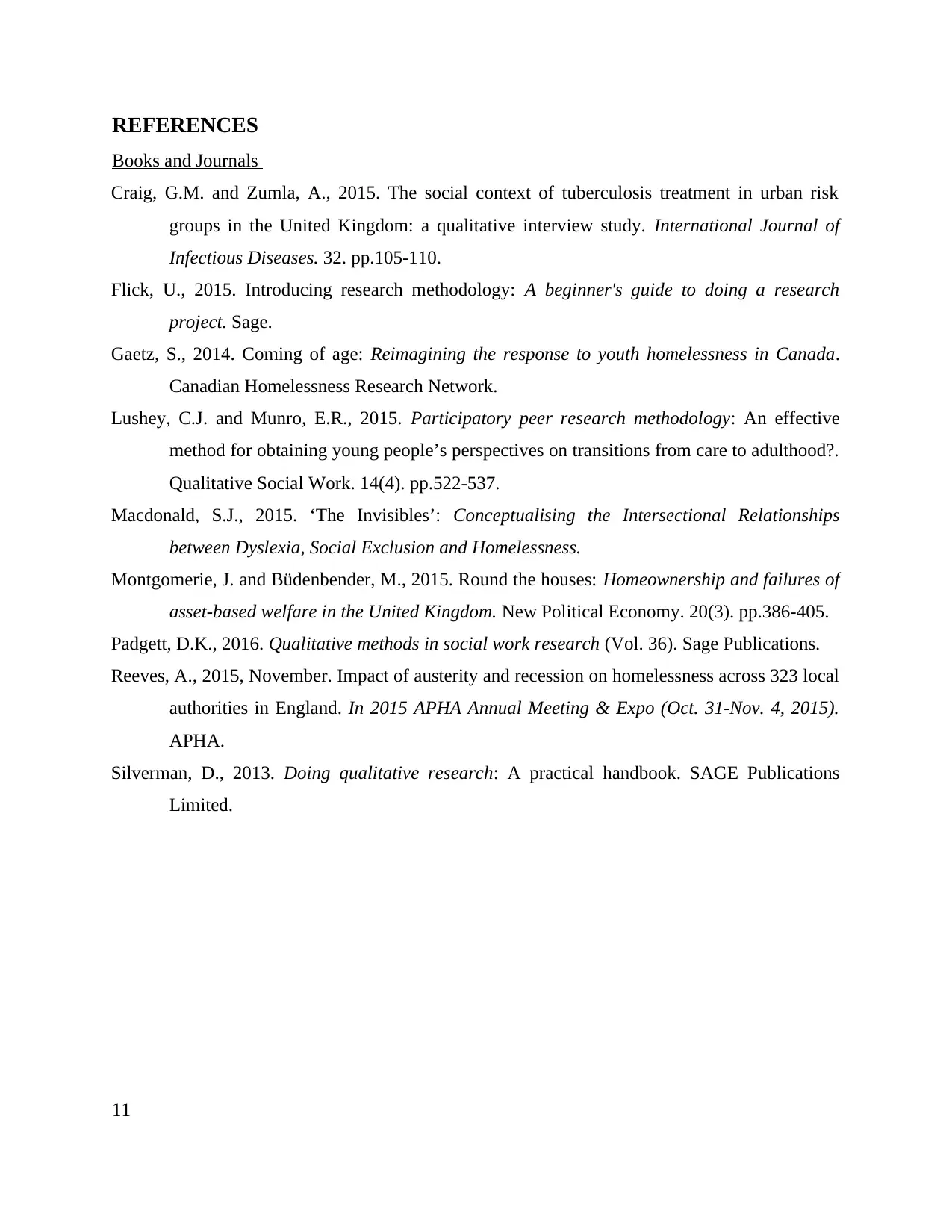
REFERENCES
Books and Journals
Craig, G.M. and Zumla, A., 2015. The social context of tuberculosis treatment in urban risk
groups in the United Kingdom: a qualitative interview study. International Journal of
Infectious Diseases. 32. pp.105-110.
Flick, U., 2015. Introducing research methodology: A beginner's guide to doing a research
project. Sage.
Gaetz, S., 2014. Coming of age: Reimagining the response to youth homelessness in Canada.
Canadian Homelessness Research Network.
Lushey, C.J. and Munro, E.R., 2015. Participatory peer research methodology: An effective
method for obtaining young people’s perspectives on transitions from care to adulthood?.
Qualitative Social Work. 14(4). pp.522-537.
Macdonald, S.J., 2015. ‘The Invisibles’: Conceptualising the Intersectional Relationships
between Dyslexia, Social Exclusion and Homelessness.
Montgomerie, J. and Büdenbender, M., 2015. Round the houses: Homeownership and failures of
asset-based welfare in the United Kingdom. New Political Economy. 20(3). pp.386-405.
Padgett, D.K., 2016. Qualitative methods in social work research (Vol. 36). Sage Publications.
Reeves, A., 2015, November. Impact of austerity and recession on homelessness across 323 local
authorities in England. In 2015 APHA Annual Meeting & Expo (Oct. 31-Nov. 4, 2015).
APHA.
Silverman, D., 2013. Doing qualitative research: A practical handbook. SAGE Publications
Limited.
11
Books and Journals
Craig, G.M. and Zumla, A., 2015. The social context of tuberculosis treatment in urban risk
groups in the United Kingdom: a qualitative interview study. International Journal of
Infectious Diseases. 32. pp.105-110.
Flick, U., 2015. Introducing research methodology: A beginner's guide to doing a research
project. Sage.
Gaetz, S., 2014. Coming of age: Reimagining the response to youth homelessness in Canada.
Canadian Homelessness Research Network.
Lushey, C.J. and Munro, E.R., 2015. Participatory peer research methodology: An effective
method for obtaining young people’s perspectives on transitions from care to adulthood?.
Qualitative Social Work. 14(4). pp.522-537.
Macdonald, S.J., 2015. ‘The Invisibles’: Conceptualising the Intersectional Relationships
between Dyslexia, Social Exclusion and Homelessness.
Montgomerie, J. and Büdenbender, M., 2015. Round the houses: Homeownership and failures of
asset-based welfare in the United Kingdom. New Political Economy. 20(3). pp.386-405.
Padgett, D.K., 2016. Qualitative methods in social work research (Vol. 36). Sage Publications.
Reeves, A., 2015, November. Impact of austerity and recession on homelessness across 323 local
authorities in England. In 2015 APHA Annual Meeting & Expo (Oct. 31-Nov. 4, 2015).
APHA.
Silverman, D., 2013. Doing qualitative research: A practical handbook. SAGE Publications
Limited.
11
1 out of 11
Related Documents
Your All-in-One AI-Powered Toolkit for Academic Success.
+13062052269
info@desklib.com
Available 24*7 on WhatsApp / Email
![[object Object]](/_next/static/media/star-bottom.7253800d.svg)
Unlock your academic potential
Copyright © 2020–2025 A2Z Services. All Rights Reserved. Developed and managed by ZUCOL.





